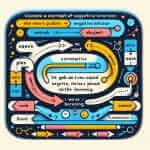Have you ever encountered a sentence like “So dedicated was he that he worked nonstop” and wondered about the grammar behind it? This unique structure, while less common, can significantly enrich your writing and speaking, pushing you closer to those coveted band 7-8 scores in IELTS. Let’s dissect this structure and explore how to wield its power effectively.
Imagine encountering these sentences in your IELTS writing or speaking:
- So captivating was the scenery that I forgot to take pictures. (Expressing the intensity of the scenery’s beauty)
- So severe was the storm that all flights were cancelled. (Emphasizing the severity of the storm’s impact)
- So persuasive was her argument that the committee approved her proposal. (Highlighting the effectiveness of the argument)
In each of these examples, the structure dramatically emphasizes the adjective (captivating, severe, persuasive) and its impact on the following clause.
Deconstructing the “So [Adjective] Was [Subject]” Structure
This structure is an example of inversion, a grammatical tool that alters the typical subject-verb order for emphasis and stylistic effect.
Frequency in IELTS
While not as common as basic sentence structures, understanding and using inversion demonstrates a higher level of grammatical dexterity—a key factor in achieving higher band scores. You might encounter this structure in reading passages and, more importantly, can utilize it in your writing and speaking to showcase your command of English grammar.
The Formula and Its Application
Here’s the formula for this structure:
So + [Adjective] + Was/Were + [Subject] + That + [Clause]
Breakdown and IELTS Usage
-
So [Adjective]: Begins the sentence with emphasis on the adjective, highlighting a quality or intensity.
- Writing (Task 1): Describe trends or changes dramatically—”So dramatic was the increase in online sales…”
- Speaking (Part 2): Make your descriptions vivid—”So peaceful was the atmosphere that I felt completely relaxed.”
-
Was/Were: The verb “to be” agrees with the subject in number (singular or plural).
-
[Subject]: The person or thing performing the action in the main clause.
-
That: A conjunction connecting the emphasized adjective to its consequence.
-
[Clause]: Explains the result or consequence of the adjective.
Mastering the Structure: Examples for IELTS
Writing (Task 2)
- Topic: The impact of technology on social interactions.
- Sentence: So pervasive has technology become that genuine human interaction is dwindling. (This sentence highlights the extensive reach of technology and its negative impact on social interaction, showcasing a good grasp of vocabulary and grammar.)
Speaking (Part 3)
- Topic: The importance of preserving cultural heritage.
- Sentence: “Well, I believe our traditions define us. So integral are they to our identity that losing them would be like losing a part of ourselves.” (This emphasizes the speaker’s viewpoint, demonstrating clear articulation and a good range of vocabulary.)
![Unlocking High IELTS Scores: Mastering the "So [Adjective] Was [Subject]" Structure 1 IELTS Grammar Inversion Illustration](https://www.ielts.net/wp-content/uploads/2024/07/ielts-grammar-inversion-66a7fb.jpg) IELTS Grammar Inversion Illustration
IELTS Grammar Inversion Illustration
Reaching Higher: Similar Structures for Enhanced Expression
Once you’ve mastered the “So [Adjective] Was [Subject]” structure, explore similar inversions:
- Such was [noun] that [clause]: “Such was the force of the impact that the car was totaled.”
- Never/Rarely/Seldom + auxiliary verb + subject + main verb: “Seldom do we see such dedication from employees.”
These variations offer further opportunities to diversify your sentence structure and demonstrate your advanced grasp of English grammar.
Common Errors to Avoid
- Incorrect subject-verb agreement: “So beautiful was the flowers…” (The subject “flowers” is plural, so the verb should be “were.”)
- Overuse: While effective, using this structure too frequently can sound unnatural. Use it judiciously for maximum impact.
- Misplaced emphasis: Ensure the adjective you’re emphasizing is truly the focal point of the sentence.
Conclusion:
Mastering inversion, particularly the “So [Adjective] Was [Subject]” structure, adds a sophisticated edge to your IELTS writing and speaking. By understanding its construction, practicing its application, and avoiding common pitfalls, you can confidently wield this tool to achieve the high scores you deserve. Remember, effective communication relies not only on vocabulary but also on grammatical finesse.


